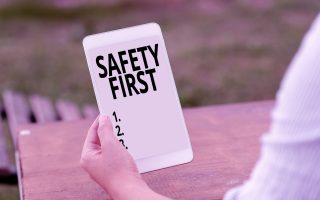
As a woman, you learn to live with a constant, low-level hum of vigilance. Society teaches a long list of “rules” to keep you safe: clutching your keys like a weapon, pretending to be on the phone, or sharing your location with a friend. Consequently, these actions become so ingrained they feel like second nature.
We perform these rituals for woman safety, hoping they will protect us. However, let’s be brutally honest: many of them are not as effective as we think. In many cases, these rituals amount to safety theater, a performance meant to make us feel in control in a world where we often are not. For that reason, it’s time to have a real conversation about what isn’t working.
1. Clutching Your Keys Between Your Fingers
This is the classic self-defense tip, with the idea being to create a makeshift weapon. In reality, most self-defense experts agree this is a bad idea. You are more likely to injure your own hand than you are to seriously harm an attacker. Instead, a better option is to hold your keys in a tight fist, with one key protruding from the bottom.
2. The “Emergency” Phone Call
When you feel uneasy walking at night, you might pull out your phone and pretend to be in a conversation. The hope is that it will deter a potential attacker. While it might make you feel less alone, it also has a major downside: it distracts you. As a result, you are less aware of your surroundings and have occupied the one hand you could use to defend yourself.
3. Dressing “Modestly” to Avoid Attention
Society often tells women that their clothing can invite unwanted attention. Fundamentally, this is a form of victim-blaming. The reality is that predators are not motivated by clothing. Instead, they are motivated by opportunity and perceived vulnerability. Therefore, what you wear has no bearing on your right to be safe.
4. Relying on Location Sharing Apps
Sharing your location with a friend or partner can provide peace of mind because it’s good that someone knows where you are. However, this is a passive safety measure. It can help people find you after something has already happened. Ultimately, it does very little to prevent an attack in the first place.
5. The “Buddy System” on a Night Out
Sticking with your friends is always a good idea. Nevertheless, the buddy system can create a false sense of security. For instance, it’s easy to get separated in a crowded bar or club. A determined predator can still isolate someone from a group, which proves it is not a foolproof plan.
6. Carrying Pepper Spray (But Not Knowing How to Use It)
Pepper spray can be an effective tool but just having it in your purse is not enough. In a high-stress situation, for example, will you be able to find it? Do you know how to disengage the safety and aim it correctly? Worse yet, an attacker can easily take it from you and use it against you if you are not prepared.
7. Avoiding Eye Contact
Making yourself seem small and unthreatening might feel like a safe strategy. You might look at the ground and walk quickly. However, some experts argue that this can signal vulnerability. Making brief, confident eye contact with passersby can project awareness and confidence, which can in turn act as a deterrent.
8. Parking Under a Bright Light
Parking in a well-lit area is standard advice, and it’s certainly better than parking in a dark, isolated corner. Still, it doesn’t guarantee safety. Attacks can and do happen in broad daylight and under bright lights. This precaution is just a small piece of a much larger puzzle.
9. Saying You Have a Boyfriend
This is a common tactic women use to get a man to stop hitting on them. It’s frustrating that some men respect the idea of another man’s “ownership” more than a woman’s simple “no.” While it can be an effective social tool, it does nothing to protect you from someone who intends to cause you harm.
10. Taking a Single Self-Defense Class
A one-day self-defense workshop can be empowering, as it can teach you some basic moves. But real self-defense is a skill that requires practice and muscle memory. A single class is unlikely to prepare you for the reality of a violent encounter. For that reason, only consistent training makes a difference.
11. Sending That “Text Me When You Get Home” Message
We all send and receive these texts. Indeed, they come from a place of genuine care and concern. But like location sharing, this is a reactive measure. It confirms that a person arrived safely, but it doesn’t do anything to ensure their safety during the journey.
The Burden Should Not Be Ours Alone
To be clear, listing these things is not meant to discourage you. It’s meant to highlight a critical point: society disproportionately places the responsibility for woman safety on women. We are the ones expected to modify our behavior, limit our freedom, and live in a state of constant vigilance. True safety will not come from a better self-defense keychain. Instead, it will come when we shift the focus from teaching women how to avoid being attacked to teaching people not to attack.
What are your thoughts on this? Let’s have a real conversation in the comments.
What to Read Next…
- Woman Safety 101: Never Ignore a Man Who Mocks You in Front of His Friends
- 8 Manipulation Tactics Narcissists Use to Compromise a Woman’s Safety
- 12 Safety Precautions Every Woman Should Take Alone at Home
- 9 Things a Woman Does When She Truly Values a Man
- 9 Security Hacks That Every Woman Should Know

Latrice is a dedicated professional with a rich background in social work, complemented by an Associate Degree in the field. Her journey has been uniquely shaped by the rewarding experience of being a stay-at-home mom to her two children, aged 13 and 5. This role has not only been a testament to her commitment to family but has also provided her with invaluable life lessons and insights.
As a mother, Latrice has embraced the opportunity to educate her children on essential life skills, with a special focus on financial literacy, the nuances of life, and the importance of inner peace.







